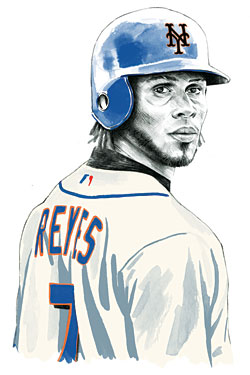
Jose Reyes is my favorite New York City athlete. Other players are more dominating, more consistent, more statistically efficient, more likely to stay off the disabled list, but no one is more purely delightful to watch play. Reyes has moments, snapshots, that are transcendent and transporting in a way that no one else on the local sports scene can match. When Reyes is healthy and engaged,he carries himself with a joy that reminds you why you started watching sports in the first place. When he smacks a line drive into the left-center-field gap at Citi Field, streaking around the bases, limbs flying everywhere, it’s baseball as it should be shown off to alien beings, the Jerry West logo of what the game can be. Reyes is one of those players everyone can agree on, from the old-school baby-boomer hustle fetishist to the new-school sabermetric vorp slide-rule crowd. If you don’t like watching Jose Reyes play, you’re not much of a baseball fan.
Ask your kids about him: They love him too. Reyes has a way of conjuring up Little League innocence, that childlike exuberance, that I-can’t-believe-I-get-to-do-this-for-a-living giddiness of adults running around in circles and getting paid for it. My favorite Reyes play was during the 2006 National League Championship Series against the St. Louis Cardinals. With a runner on first and one out, a Cardinal hit a line drive right at Reyes, who caught it instinctively. A split second passed, and Reyes, realizing a beat late that he could have dropped the ball and pulled off a double play, quickly let the ball fall to the dirt and threw it to second base. The umpires, sentient beings that they were, called the batter out, nullifying Reyes’s silly ruse. Whereupon Reyes, in one of the most important games of his baseball career, started laughing and cartoonishly shrugging his shoulders, a goofy “Who, me?” look on his face: the kid caught with his hand in the cookie jar. It was hilarious, just a kid playin’ ball, trying to sneak one past ya, can’t blame a guy for tryin’.
That was five years ago. Jose Reyes was 23 years old, and the Mets were a team on the rise, built around Reyes, David Wright, and Carlos Beltran. A team that came one key hit away from the World Series, a team that promised to be even more in the years to come. Those heydays never came; the past five years of Mets baseball have brought nothing but unrelenting pain for the Mets and for Reyes, who has battled countless injuries and lost. It didn’t turn out like it was supposed to.
But lo, Reyes is still here, and at last he is healthy and looks like Jose Reyes again—just in time for rumors to begin swirling that the Mets might try to trade him, a move that will say a lot about the direction the Mets’ new management plans to take this franchise in. Jose Reyes is a player any team in baseball would give just about anything to have. Everyone, alas, but the Mets.
The 2011 New York Mets—on the field, anyway—have not been the embarrassment they were expected to be, which is a far cry from saying they’ve been good. They’re in last place in the National League, playing in front of sparse crowds, but that’s not a major shock: The National League East has turned out to be one of the better divisions in baseball, and the Phillies, Marlins, and Braves appear unlikely to falter over the next five months. The Mets have had the predicted pitching woes and then some, thanks to the invisible injury snipers that have been living in Flushing the last three seasons. And while some of the Mets’ bigger-name stars like Wright and Beltran have been healthy and productive, it’s clear to everyone—not least of all the new Mets management group—that, as currently constituted, this is not a World Series–caliber ball club. Again, this is not a surprise: The Mets came into the season under construction, in a holding pattern, waiting for nearly $60 million of dead contracts to expire and the Wilpon-Madoff financial follies to be resolved in the off-season. The Mets are rebuilding. Considering what they have been through in the past five years and how much money they’ve spent for the privilege, this is precisely what they should do.
The problem is that Reyes accounts for $11 million of that potential payroll-shaving in October. For the first time since the Mets went from World Series contender to nightly Letterman joke, Reyes is 100 percent healthy, and he has responded by having the best year of his career. He currently has the highest batting average and OPS of any season since he entered the league, and he is on pace to steal almost 60 bases. He’s doing this while playing a premium position, shortstop, as well as anyone in baseball. He leads National League shortstops in hits, doubles, triples, and stolen bases and is second in batting average, OPS, and runs despite playing for a team that’s in the middle of the pack in scoring. He is, in short, having an All-Star season; odds are he’ll be leading off for the National League in July’s All-Star game in Arizona (presuming, of course, that some Phoenix immigration cop doesn’t try to spontaneously deport him).
But which team’s jersey will he be wearing? It is the Mets’ profoundly rotten luck that once they finally get Reyes healthy and stroking like they’ve needed him to for four years, the rest of the team has fallen lame all around him. The Mets’ new general manager, Sandy Alderson, and his gang are facing quite a pickle. It is one thing to clear out dead weight and build for the future. It is another thing altogether to trade away the team’s most popular, likable player while he’s having a career year and is only 27 years old.
The Mets have two options. Neither of them is ideal. Or both are. The first is to hang on to Reyes, ride it out, and take their chances that he will re-sign with the team in the off-season. From all reports, Reyes, a non-flashy guy who lives with his wife and three children in Manhasset, prefers to stay in a situation he finds comfortable; keeping him this season makes it more likely he’ll give favored-nation status to the Mets. (The team would have an exclusive negotiating window with Reyes after the season ends, as well as the goodwill of letting Reyes know he’s wanted.) Keeping Reyes throughout 2011 would give fans a reason to continue to come to Citi Field throughout September, when the Mets will have been long out of the playoffs, and they might even sell some more of their most popular jersey, too.
The other option is to trade him to a league full of teams starving for him. The most likely suitors are the defending World Series champions, the San Francisco Giants, who desperately need a shortstop and a leadoff man; with Reyes, they’d be getting one of the best in both capacities. (Other potential trade partners are the Cardinals, the Angels, and the Reds. Derek Jeter isn’t playing badly enough yet for the Yankees to get involved, mercifully.) There’s a strong argument to be made for shipping Reyes out before it’s too late, before the price goes down or, perish the thought, he gets hurt again.
If the Mets truly are rebuilding and reconstituting their entire organization, isn’t Reyes exactly the type of player you flip for young prospects? He’s at the end of his contract, he’s injury-prone, he’s reliant on his speed for much of his value (speed that, as he gets older, will fade), and he fits an obvious need for a series of highly motivated trade partners. The Giants have a trove of young prospects—the Mets should be eyeing outfielder/first-baseman Brandon Belt and shortstop Brandon Crawford, just for starters—which the Mets need now more than anything else; they don’t have many top-tier prospects left in their system and arguably haven’t produced one since, well, Reyes. (You can make a case for Ike Davis if you’d like.)
There’s a catch there, too: If you want the mother lode of prospects from the Giants (or whomever), you’ll have to let them negotiate a contract extension with Reyes in order to get them to give up that much. If you trade Reyes as more of a rental—as he would be with St. Louis—you’ll receive less in return … which makes trading him seem beside the point. (Alderson has admitted that a trade of Reyes would be an admission that he is unlikely to re-sign.)
Then again, what are you keeping him around for? Are these Mets winning a championship in the next five years, Reyes’s prime? With finances the way they are, can they even afford to sign him in the off-season? (Particularly when he might command numbers similar to what Carl Crawford signed for with the Red Sox: seven years, $142 million.) What if he gets hurt again?
But do the Mets want to be the sort of franchise that trades away its best players in their prime because of financial concerns? What are we, Minnesota?
It is an impossible situation to resolve: Both sides of the Trade Reyes debate are correct, and prudent, and convincing. But the Mets have to make a decision. In a season in which it has felt like management is just idling and biding its time, this is the first and perhaps most important decision of the new regime. I’m glad I’m not the one who has to make it. We’re going to learn a lot, perhaps all we need to know, about Alderson & Co. by which direction they take. If they keep Reyes, they show that they’re willing to risk part of their future to keep fans happy and build around a fragile superstar. If they trade him, they show that they’re willing to trade anyone, regardless of sentiment, to fix this franchise in the long term.
And yet whichever path they choose, as any die-hard Mets fan knows, will probably be the wrong one.
E-mail: will.leitch@nymag.com.
